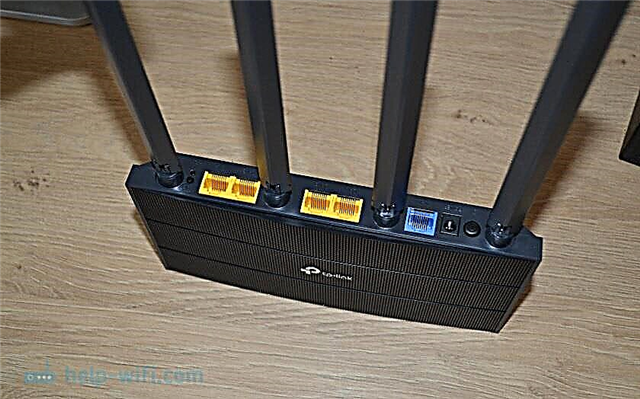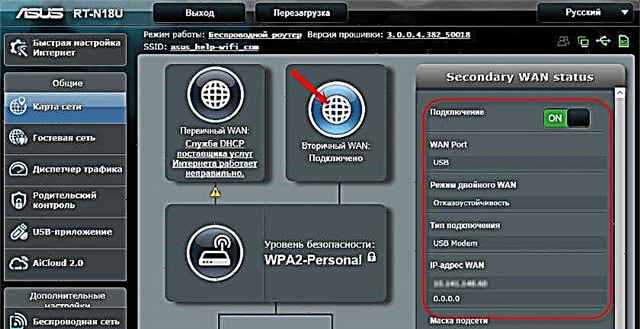I recently tested the "Dual WAN" function on my ASUS router. I decided to tell you what this function is, for what purposes it can be used and how to configure it correctly. A little background. Earlier I had an ASUS RT-N18U router installed which worked with a USB modem. Now there is the same RT-N18U, but the Internet is no longer via a 3G modem, but via WAN. We carried out the optics, and now a network cable from the FORA EP-1001E1 terminal is connected to the router.
Everything worked great, until at one point access to the Internet was not lost. I called the provider, they said that someone knocked down a post and the line was cut off. They'll fix it soon. Since I needed access to the Internet, I decided to connect the USB modem back to the router and configure the "Dual WAN". Yes, one could do without this feature, and just switch to the optics when it is repaired. But I decided to check what it is and tell you about it.

Dual WAN function allows you to set up two internet connections on your ASUS router. It can be WAN (see what is WAN) and USB (modem, or Android phone as a modem), or WAN and one of the LAN ports. That is, the Internet (cable) can be connected to the WAN port, and also to one of the LAN ports. For example, when you have two providers. It seems to me that using this function you can also reassign the WAN port. If it's broken, for example.
This scheme solves two problems (dual WAN mode):
- fault tolerance - when one connection is the main one and the other is the backup. For example, as in my case. The Internet via WAN disappeared (line break, or something else) and the router automatically switches to a backup connection. The second WAN is used. In my case, a USB modem.
- Load balancing - the router will simultaneously use two Internet connections, distributing the load between them. This will increase the network bandwidth and speed. Since the load will be distributed between the two communication channels.
I don't know if someone would use this function to distribute the load between two connections (providers). Although, in some situations, such an opportunity may come in handy. But setting up a backup connection is a useful thing. Especially in those cases when you have video surveillance, control of a heating boiler, or other devices that need access to the Internet. The Internet was lost on the main channel and the connection with the cameras was lost. And after setting up a dual WAN, the ASUS router will almost instantly and automatically switch to the backup connection. And if necessary, return to the main channel when it works (if you specify this in the settings).
This is especially true when the router is installed somewhere in the country, or at some facility that you cannot quickly get to in order to solve the connection problem.
Configuring Dual WAN on ASUS Router
To configure, you need to go to the ASUS router control panel at 192.168.1.1. Then open the "Internet" section and go to the "Dual WAN" tab.
And then point by point:
- The switch next to the "Enable dual WAN" item is set to ON.
- Primary WAN - choose from the list the connection that will be the main one. Most likely, this will be the WAN port.
- Secondary WAN - we indicate the second connection. In Failover mode, it will be redundant. I have this "USB". You can also select "Ethernet LAN". If you choose this option, you will also need to specify the number of the LAN port that will be used as the second WAN.
- Dual WAN Mode - this is what I wrote about above. "Fault Tolerance" or "Load Balancing".
- If you want the router to automatically switch to the first WAN (when it works), and not to remain on the backup connection, then you need to check the box next to "Allow crash recovery".
These were the main settings. Let's consider also the network discovery settings.
- Detect Interval - most likely the time interval is set here after which our ASUS will switch to the backup connection after the main connection is broken.
- Failover time - This setting will only be available if you have enabled the "Enable crash recovery" feature. Here you can specify the time (in seconds) after which the router will switch to the main channel (First WAN). After it becomes active again (connection appears).
- Failback Execution Time - to be honest, I didn't quite understand what this setting is. Most likely this is the time after which the router will check the availability of the connection on the primary WAN.
- Enable Ping to Internet (ping to the Internet) - It was disabled for me. If enabled, you also need to specify the site to which the router will ping (for example, google.com). As far as I understand, the router needs this in order to check if there is Internet on a certain communication channel.
Screenshot with my settings.

After setting, click on the "Apply" button and wait for the router to reboot.
Go to the settings again to configure the Internet connection on each WAN. Or just check your settings.
In the "Internet" section, in the "WAN Type" menu, select "WAN" and check / set the connection settings to the provider. I have a "Dynamic IP" so nothing needs to be configured.

We save the settings. In the "WAN Type" menu, select the second "USB" or "Ethernet LAN" connection and set the necessary parameters for connecting to the Internet through this port. I have this "USB", and I set up a connection to my carrier via a modem. I wrote about setting up a 3G / 4G modem on an ASUS router here.

We save the parameters and go to the main page "Network Map", or enter the settings again after restarting the router.
This is what the connection card looks like when the Internet stopped working on the primary WAN (via the cable that is connected to the WAN port).

As you can see, the "Primary WAN" connection is down and the router automatically starts using the "Secondary WAN".
And when the main connection worked (the line was repaired), then the router switched to it, and the backup connection went into standby mode.

This is how it works.
You can highlight one of the connections and the information and connection status will appear on the right.

I didn't even expect everything to work so well. I tested several options. I disconnected the connection and watched the ASUS router switch to the backup channel. Everything works smoothly. The connection reliability is doubled after configuring this function. Especially if you use another cable as the second WAN, and not a USB modem. But the modem, as a rule, works stably. It is enough for a spare communication channel.
Write in the comments how you use "Dual WAN" and for what tasks.











